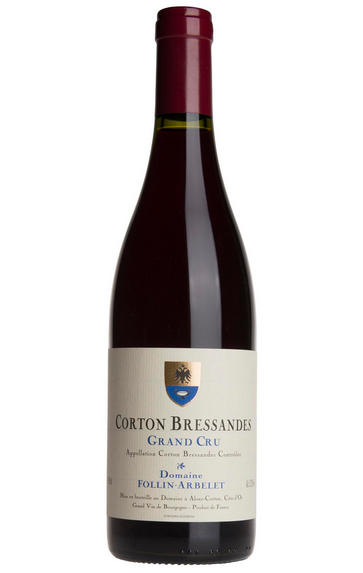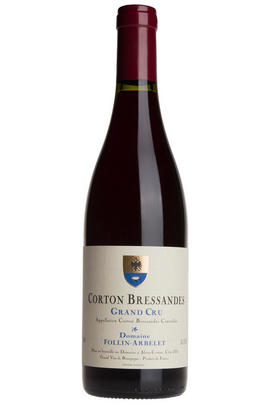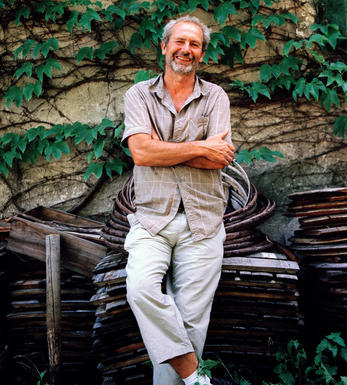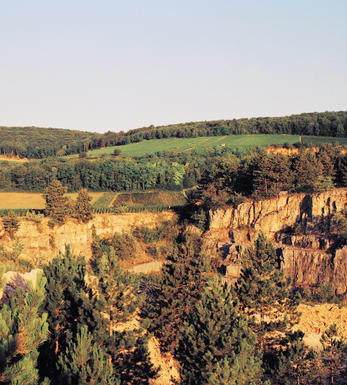
2014 Corton-Bressandes, Grand Cru, Domaine Follin-Arbelet, Burgundy

Critics reviews
Neal Martin - 31/10/2017
About this WINE

Domaine Follin-Arbelet
Franck’s ancestors owned vineyards in Aloxe-Corton, which they sold off towards the end of the 19th century.
As a child, he spent holidays in the village, working part-time in the vineyards and, in due course, marrying a local girl, Christine. Her family had some vines – enough for Franck to set up as a vigneron in 1993, subsequently adding further vines through rental agreements. In 2017, Franck was joined at the domaine by his son, Simon.
In the vineyard
Franck favours the most simple and natural form of farming possible. The grapes are entirely destemmed, vinified in wooden vats for about two weeks. The wines are aged for 18 months in barrel, initially with 20 to 25 per cent new wood before racking into older casks after 12 months.

Aloxe Corton
These two Grand Cru vineyards, Corton and Corton-Charlemagne, lie astride three villages at the northern end of the Côte de Beaune: Ladoix, Aloxe-Corton and Pernand-Vergelesses. The main body of the hill of Corton faces due south, with an extended flank exposed to the east, and another facing westwards. The white wines mostly come from west and south-west expositions, along with a narrow band around the top of the hill.
The Emperor Charlemagne owned vines here in the eighth century, and legend has it that his wife insisted he planted white grapes so as not to spill red wine down his beard and clothes. Corton-Charlemagne is always white and there is also a theoretical Grand Cru appellation called, simply, Charlemagne, which is never used. Corton is almost entirely red but there are a few white wines too.Ladoix is a rarely-seen appellation, as most wine here are sold as Côte de Beaune Villages. Aloxe-Corton is better-known, but as with Ladoix the best vineyards have been designated as Corton and Corton-Charlemagne.
There are also 25 lieux-dits that may be used on wine labels, together with Corton: Les Bressandes, Les Chaumes, Clos des Meix, Clos du Roi, Les Combes, Le Corton, Les Fiètres, Les Grèves, Les Manguettes, Les Maréchaudes, Le Meix Lallemand, Les Paulands, Les Perrières, Les Pougets (Pougeots), Les Renardes, La Vigne au Saint, Les Basses Mourottes, Les Carrières, Clos des Cortons Faiveley, Les Grandes Lolières, Le Rognet et Corton, La Toppe au Vert and Les Vergennes.
- 90 hectares of village Aloxe-Corton
- 38 hectares of Premier Cru Aloxe-Corton
- 118 hectares of village Ladoix
- 14 hectares of Premier Cru Ladoix
- 72 hectares of Corton-Charlemagne. The finest from En Charlemagne (Pernand) and Le Charlemagne (Aloxe)
- 160 hectares of Corton. The best from Clos du Roi, Bressandes, Pougets

Pinot Noir
Pinot Noir is probably the most frustrating, and at times infuriating, wine grape in the world. However when it is successful, it can produce some of the most sublime wines known to man. This thin-skinned grape which grows in small, tight bunches performs well on well-drained, deepish limestone based subsoils as are found on Burgundy's Côte d'Or.
Pinot Noir is more susceptible than other varieties to over cropping - concentration and varietal character disappear rapidly if yields are excessive and yields as little as 25hl/ha are the norm for some climats of the Côte d`Or.
Because of the thinness of the skins, Pinot Noir wines are lighter in colour, body and tannins. However the best wines have grip, complexity and an intensity of fruit seldom found in wine from other grapes. Young Pinot Noir can smell almost sweet, redolent with freshly crushed raspberries, cherries and redcurrants. When mature, the best wines develop a sensuous, silky mouth feel with the fruit flavours deepening and gamey "sous-bois" nuances emerging.
The best examples are still found in Burgundy, although Pinot Noir`s key role in Champagne should not be forgotten. It is grown throughout the world with notable success in the Carneros and Russian River Valley districts of California, and the Martinborough and Central Otago regions of New Zealand.


Buying options
Add to wishlist
Description
Fine, bright medium pink-purple in the glass, there is good stuffing to this. It has a solid bouquet with a good concentration of red fruit. It starts strict but then the fruit swells on the palate, with a generous intensity, all held in place by a firm structure.
Franck Follin-Arbelet reports a relatively small crop, after a difficult flowering (too hot and dry) and some hail in Pernand-Vergelesses and Aloxe-Corton. Nonetheless the grapes resisted the damp middle of the summer well and ripened properly at the end. Harvest began on 13th September and though the sorting table was needed to remove hail damage and dried grapes, the results here are very successful in 2014.
wine at a glance
Delivery and quality guarantee